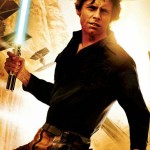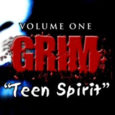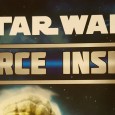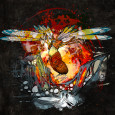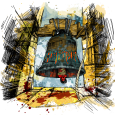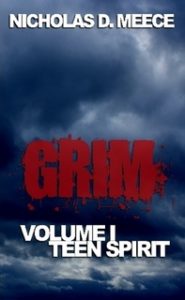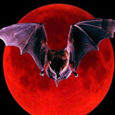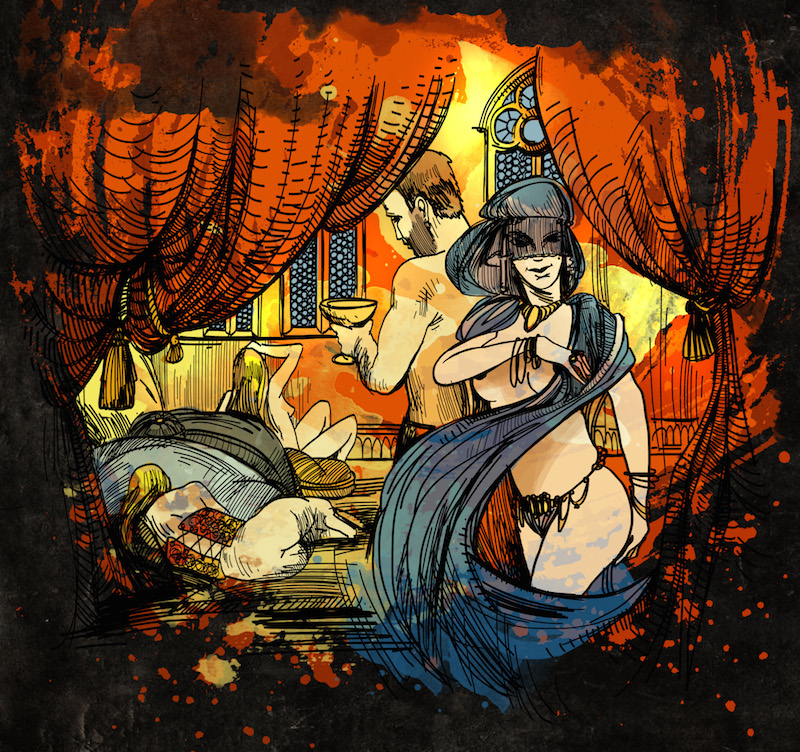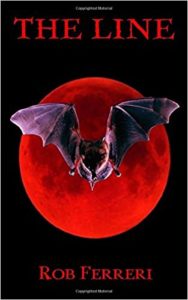 Vampires are a staple of Halloween and one of the most famous horror icons around. So I figured reading a vampire tale for Hallow-Reads was as good an idea as any. That’s when I was presented with The Line by Rob Ferreri, a self-published novel about a team of vampire hunters.
Vampires are a staple of Halloween and one of the most famous horror icons around. So I figured reading a vampire tale for Hallow-Reads was as good an idea as any. That’s when I was presented with The Line by Rob Ferreri, a self-published novel about a team of vampire hunters.
The Line tells the story of Alexander, an immortal ex-vampire and his mission to hide an ancient amulet from Dorian, his ex-master. When the amulet is discovered in present day New York, Alexander assembles a team to help him combat the vampire threat and protect the amulet. The team, which he dubs “the Line” are chosen ones, people who come from a long line of vampire slayers. The plot boils down to Buffy the Vampire Slayer meets The Avengers and works in many ways. However, there are quite a few ways that it just falls flat.
The book opens with a scene of our Alexander being healed of his vampirism and turning against his former brethren. It’s an interesting concept, one that doesn’t get explored often in pop culture, but it also doesn’t get explored much here, either. We know Alexander had a history as a vampire and worked with Dorian, but Ferreri never delves into that. There’s no back story showing us how Alexander became a vampire or what regrets he may have. We’re only told he was a vampire, isn’t any more, and now wants to rid the world of vampires.
The dialogue tags were the most tedious part of the book. Dialogue tags should be straightforward as the most effective ones are a simple “she said” or “he asked.” Sure, it’s great to mix them up a bit for some exclaiming, questioning, or accusing. But The Line makes them all as homogenous as possible. Every dialogue tag follows all of the dialogue. Every time. Now, this isn’t how most authors handle it; in scenes with two characters, for example, it’s generally easy to follow the flow of the dialogue, making the need for a tag each time unnecessary. But Ferreri uses them for every line and it gets very distracting.
From my understanding, The Line was originally written as a screenplay, and after reading it, that’s fairly obvious. The dialogue tags, for example, reminded me of slugs, the character name that precedes each line of dialogue, making it easy for the actor to know which lines are theirs and which belong to their costars. Sure, Ferreri punches up his dialogue with adverbs, but these are little more than parentheticals, the stage direction used to indicate how the actor should deliver the line.
This isn’t the only similarity The Line as a novel has to a screenplay. The book focuses a lot on the action; every few pages, a new action scene occurs. Whether it’s a showdown between the protagonists and the bad guys or some sort of training exercise, action scenes take precedence. Which makes sense considering The Line is a vampire based action adventure more than anything else. However, this focus detracts from any sort of character development, of which there is very little.
The Line is straight forward, to the point, and exactly what one could expect from a ninety minute action flick.
Does a novel need chapters of deep backstory to be enjoyable? No, not at all, but unlike movies, novels aren’t constrained by a certain length. There’s no hard and fast rule that a novel should be a set number of pages. In that sense, novels have an advantage over films when it comes to character development.
The Line implements a sort of ticking clock, yet another action movie trope. Alexander and Co must stop Dorian from getting the other half of the artifact before the next lunar eclipse or the world will suffer. Because of this, the plot moves at hyperspeed. Characters are introduced, destinies explained, trainings held, and lots of fight. There’s no time to get to know the cast. We see them put through the wringers of training a total of one time before they accept their fate. They trust each other implicitly after knowing each other for at most a couple of days. There’s very little internal conflict and it gets resolved in a page or two, which diminishes the stakes.
The parallel between The Line as a novel versus a screenplay makes sense when you look at author Rob Ferreri’s history. He’s worked on a few full-length feature films, most of which were made prior to the publication of The Line. He clearly has a strong grasp of writing, but it seems that scripting is a difficult habit to shake. Novels and screenplays are two different creatures and what works in one doesn’t necessarily work in the other. I don’t feel that his writing style is bad; just that it’s not the ideal approach for a novel.
Don’t get me wrong; there are quite a few good parts about The Line, most notably the character introductions. When we meet each of the characters, they get the spotlight in their own little vignette of a story. Detective Jay Hong is ambushed during one of the biggest cases of his career. The Blades brothers, Diego and Julian, are career criminals and we first see them during a high-octane car theft and eventual chase. Lena Somnianti is a sophisticated artist and fencer, a well-travelled and intelligent woman. They all make grand entrances, yet don’t really live up to their promise. Sure, they’re competent enough in their own right but none of them ever feel fleshed out besides what we learn at the outset.
This is really the fatal flaw of The Line. It never really lives up to its own story. It’s complete, has a plot and a diverse cast, but that’s the bare minimum when dealing with a novel. As a film, The Line would have been magnificent fun. More Underworld than Anne Rice, it didn’t quite fit into my idea of “horror” so it probably wasn’t the best entry for Hallow-Reads, but I still found myself engrossed in the tale as it unfolded.
The Line is available on Amazon. You can also see more of Ferreri’s work by visiting his comic publisher, Evil Kat Comix.
Grade: C
Don’t forget to try our Ten Family Friendly Halloween Movies to help lull the kiddos into a candy coma! Afterward, you can set the mood with Five Albums to Flesh Out Your Halloween Playlist and huddle under the covers with Netflix and Chilling – Halloween Movie Edition. Any other off-beat Halloween suggestions to throw our way? You can let us know on Twitter @SubCultured or come party like its 1599 in our Discord server!
Halloween is one of my favorite holidays. Besides all of the cute decorations, cooler weather and delicious special edition food and candy, it’s also the time to plant oneself in front of the television and binge watch scary movies. But what does one do when movies get boring? Turning to books is usually a good idea. Thankfully there’s a subset of writers who focus on telling spooky, scary, or downright grisly tales that are best enjoyed during Halloween. I had the chance to check out one of these tales, Grim, Volume I: Teen Spirit, by Nicholas Meece.
Teen Spirit starts with a grisly murder outside of a nightclub in a small town before transitioning to the story of Steve, a teenager and budding writer, and his best friend, Jen. They share a passion for filmmaking and horror movies, so when Steve tells Jen about the murder and convinces her to investigate it with him, she’s all in. The murders don’t stop there, though, as the Reaper, as he’s known, tears through the town, killing people very close to Steve’s and Jen’s houses.
While I enjoyed Teen Spirit, I do have to say it’s full of missed potential. There are a lot of great moments in it, such as the opening prologue with the murder, which sets the tone for the horror-themed story. However, once our main characters are introduced, a lot just seems to get lost along the way. We meet Steve and find his passion for writing leads him to lock himself in his bedroom for hours on end to finish a work in progress. He’s secretive about his hobby, not allowing anyone to read his stories until he feels they are perfect. He’s in love with his best friend Jen and wants their relationship to blossom into more than just friendship, but they also plan on moving to California and living together, which is slightly weird but at least makes some sort of sense.
Steve gets the most depth while, unfortunately, Jen is more of a one-note character. We know she’s interested in filmmaking and wants to move to California. She likes Steve’s company but doesn’t see him romantically like he sees her. That is, until she’s told that she does see him romantically by a mutual friend. It’s an odd exchange and one that doesn’t really feel natural. In fact, most of the women in the book come off as caricatures, more like plot devices than real women. The exchanges between Jen and her friend Angela feel forced and stilted. There are so few of them that they’re easy to overlook, but the book is so short that these exchanges are huge chunks of the word count.
I thought the story started to pick up around the time Steve convinces Jen to investigate the murder with him. This could have made for an interesting tale and was the thread that I was most looking forward to; two teenagers struggling to use second hand knowledge of police procedurals and figure out who committed a grisly murder would have made for an intriguing tale. Couple that with the twist ending and Steve’s true agenda could have made it even more engaging. It soon becomes apparent, though, that their sleuthing isn’t the purpose of the tale. Meece is taking his love for horror movies and creating a slasher story. However, with a little fleshing out, he could have blended the two genres and created something with a little more meat on the bone.
That’s not to say Teen Spirit isn’t entertaining. It’s just heavily bogged down in horror movie tropes. A couple of fresh out of school kids in their sexual prime. An alcohol-fueled house party that swells out of control. The caring, housewife who’s concerned for the wellbeing of her taciturn son. The inclusion of all of these seem intentional based on Meece’s love of horror. After reading through Teen Spirit, I didn’t quite make this connection and the tropes bothered me. However, I dwelled on the story for a few days before starting writing this and I developed a deeper appreciation for it.
It’s hard for me to go into depth for a review of Teen Spirit only because of how short the story is. I read it entirely in a single train ride of only about an hour, which isn’t a lot of time for a “book.” That’s why my biggest disappointment with Teen Spirit is its length. As I mentioned earlier, there were plenty of areas that Meece could have elaborated on the story, delving deeper into character histories and motivations and actually following through with Steve and Jen’s intentions of tracking the killer. I assume he didn’t do this because he intended to write a short and sweet slasher tale which, if that is the case, he at least succeeded in doing. One benefit Teen Spirit does have is its cliffhanger ending, hinting at a much larger story looming in the distance. As of the time I’m writing this, there has not been a release of Grim, Volume 2, which is slightly disappointing. Hopefully, that’s still on Meece’s “To Do” list and hasn’t been abandoned completely.
All in all, I would recommend Grim, Volume I: Teen Spirit if you’re bored with horror movies on Netflix and are just looking for a change of pace. While it’s not as deep as a Stephen King novel, it provides a quick dose of horror-fueled entertainment. Not too long to get boring, but just long enough to create a creepy, slasher atmosphere. And if you crave more, you can always check out Meece’s non-fiction and movie reviews over at www.morbidmuch.com. He’s definitely a proponent of horror and a voice that adds to the genre.
Grade: B-
Don’t forget to try our Ten Family Friendly Halloween Movies to help lull the kiddos into a candy coma! Afterward, you can set the mood with Five Albums to Flesh Out Your Halloween Playlist and huddle under the covers with Netflix and Chilling – Halloween Movie Edition. Any other off-beat Halloween suggestions to throw our way? You can let us know on Twitter @SubCultured or come party like its 1599 in our Discord server!
Recently, I was asked to write an advance review for a forthcoming science fiction novel from a small press. I jumped at the opportunity to read the book before fully contemplating if it would be worth the time. Smaller presses are always a gamble in terms of quality, both with the writing and the printing, so for all I knew I was in for a terrible reading experience. I decided to plow through with the review anyway and soon found Leech Girl Lives by Rick Claypool and Spaceboy Books in my inbox. So, were my fears justified or was Leech Girl Lives worth the effort of a read through?
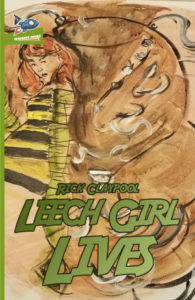 Leech Girl Lives takes place in a dystopian future where the majority of humanity has died out and what’s left live in a domed city called the Bublinaplex. While the Bublinaplex is surrounded by a “Fungus Wasteland” filled with large, horrendous and terrifying creatures, the people have managed to build a pretty stable world which is overly concerned with safety. This is where our protagonist comes in.
Leech Girl Lives takes place in a dystopian future where the majority of humanity has died out and what’s left live in a domed city called the Bublinaplex. While the Bublinaplex is surrounded by a “Fungus Wasteland” filled with large, horrendous and terrifying creatures, the people have managed to build a pretty stable world which is overly concerned with safety. This is where our protagonist comes in.
Margo Chicago is an Art Safety Inspector who investigates all works of art put on display to ensure that the artwork doesn’t hurt anyone. She has a fairly important job because the denizens of the Bublinaplex are all encouraged to work on some sort of “creative pursuit.” Some of these are worthwhile, like painting and singing while others, like Margo’s desire to crochet cats, are a little offbeat. Others still are just asinine, like Margo’s boss and his creativity in stringing nonsense words together in everyday conversations.
Due to a freak accident, Margo gets a pair of giant parasitic leeches attached to her arms. The leeches slowly eat away at her flesh and, through their symbiotic nature, become her new arms. It’s a unique concept. Although it sounded strange at first and had me questioning what kind of book I was reading, eventually the idea settled in and just flowed with the narrative. I wouldn’t have imagined that I’d enjoy a concept like that but I surely did.
Leech Girl Lives is author Rick Claypool’s first novel and that’s fairly evident in the way the book is written. Claypool builds his world and presents his novel using simple prose, which I liked. Lots of science fiction authors use long, flourishing prose and convoluted sentence structure that may sound pretty but can be confusing when trying to build an in-depth world. Claypool shirks that and just lays everything out on the table in easy bits for the layman. Whether this was intentional or just a byproduct of not finding his unique voice yet, I’m not entirely sure but the move worked in this instance.
One move that was intentional was the way Claypool split the chapters for the first third of the book. Each chapter vacillates between “Earlier” and “Later,” clearly delineating two different time periods. It’s an effective strategy that made the story more enticing; each time I finished one section, I wanted to find out what happened next but I had to read through a different section that piqued my interest just as much. Unfortunately, once the two sections converge, the story runs somewhat flat. It managed to remain interesting, but it lacked the oomph of the previous section.
The novel is also split into two distinct books, named Book One and Book Two. While I enjoyed Leech Girl Lives in its entirety, I did start to feel weighed down by the time I got to Book Two. It’s not that the second part wasn’t good; it’s just that I’d become burned out by the time I got there. I’d already gone through an entire adventure with Margo and her leech arms so to be thrown into another one right away was exhausting. I would have preferred if Leech Girl Lives ended at the first ending, with Book Two comprising an actual second book.
Doing so would have also allowed Claypool to expand on some of the themes he brings up in Book Two. While Book One dealt with the idea of stifling expression through the Art Safety’s mission to have artists alter any work they deem unsafe, Book Two explores the idea of a corporate run state as well as the division between the rich and the poor. By day, Rick Claypool is an activist who works with an organization that fights corporate power so if there would be anyone who can successfully integrate the dangers of a corporate state taking power in a silly little sci fi book, it’d be him. The way he breaks down the company’s rise to power makes us believe that the city would accept the corporate power, but everything that happens in Book Two happens so fast that it almost comes off as hokey despite the gravity of the theme. Claypool spends too much time focusing on scenes that don’t have much of an impact while breezing through others that are far more interesting. Characters speak in awkward, unnatural ways and the action doesn’t serve the plot but merely acts to hasten the transition to the next scene. I would have enjoyed it more if he slowed down and delved further into this new world he’s introduced. Allowed us to get to know a few of the newer characters better and see why they do what they do and how the corporation changed them from their previous lives.
The characterization is really the weakest part of Leech Girl Lives. Claypool focuses on Margo and spends a lot of time making sure she’s as fleshed out as possible, which is to be expected of the protagonist. Unfortunately he does this to the detriment of the supporting cast. Margo is surrounded by many unique and interesting people but they never feel whole. For example, Margo has a great relationship with her mentor, Cuthbert. Though we get a peak at Cuthbert’s home life, all we really know about him is he’s a great cook and he cries a lot. Even the book’s main protagonist, Lorcan Warhol, is a two-dimensional foil to Margo. Sure, his character takes an interesting twist during Book Two, but at a certain point he disappears and has no impact on the rest of the book. He had the makings of an interesting character but he’s flung off without a second thought.
I enjoyed Leech Girl Lives. The simple prose aside, the book played with some deep sociological themes and really dived into the darker aspects of society. Even the superficial nature of Margo’s affliction, forming a symbiotic relationship with a pair of parasitic leeches, was handled in a way that felt natural and believable. That’s not to say the book doesn’t have its flaws; in fact, there are quite a few of them, but they’re easily overshadowed by the depth of the symbolism. All in all, I’d recommend Leech Girl Lives if you’re looking for a fun adventure that doesn’t require too much brain power to really understand and enjoy.
Leech Girl Lives by Rick Claypool is available on September 26th from Spaceboy Books.
Grade: B-
Gollancz, an imprint of the Orion Publishing Group with Liber Primus Games, the indie developer and creator of gamebook series Narborion Saga, today releases a new trailer and art assets of their new joint project – an addictive adventure gamebook based on the world-class novelist and Crysis 2 and Syndicate writer Richard Morgan’s book trilogy A Land Fit for Heroes, who so graciously sat down for an interview with us earlier this month.
Based on Richard Morgan’s trilogy of dark fantasy novels, The Steel Remains, The Cold Commands and The Dark Defiles – A Land Fit For Heroes is the new multiplayer interactive gamebook experience telling the story of three unlikely heroes with three interlocking storylines. In keeping with the gamebook adventure format, the reader decides upon their fates as they proceed through the narrative.
In the first of its kind, bestselling author Richard Morgan brings his dark and violent trilogy of novels to life as a three-player gamebook set in the world of A Land Fit For Heroes with the first book in the trilogy delving into the traumatic and tortured lives of the book’s protagonists.
A Land Fit For Heroes will be one of the first gamebooks of its kind to allow players to choose the sexual orientation of their character, which mirrors the diversity of Richard Morgan’s book trilogy characters. The gamebooks also aims to retain the graphically violent nature of combat and adult themes from the novels.
This morbid fantasy title is coming to the Google Play Store for Android devices, App Store for iPhone, iPad, iTouch and Amazon for Kindle Fire at the end of October. The title will also be launching on Steam for Windows PC in December.
Kimmie Britt
Editor
@killerr_queen
Though a novelist at heart, London born author Richard K. Morgan has quite the resume, having taken a dip into different corners of the writing pool. In addition to writing the story for 2011’s Crysis 2 for noted video game publisher, Electronic Arts, Morgan has also gone a few rounds with Marvel’s spy extraordinaire, Natasha Romanoff, and is currently penning a fantasy trilogy starring a gay protagonist, a surprising rarity within the genre. We hopped on the chance to discuss these things as well as his current project, a digital gamebook of his 2008 fantasy series, A Land Fit For Heroes.
Kimi Britt: At what point did you make the decision that being a writer was something you wanted to do for the rest of your life?
Richard Morgan: Well, early enough that I can’t really remember making it! J K Rowling has a nice way of putting it – she said once in interview that ever since she was old enough to understand that there were people who made their living from writing stories, that was what she wanted to be. Same for me.
KB: Were there any specific works or authors who were some of your early inspirations?
RM: I think there was always a pretty even divide between my SF and Fantasy inspirations and then the stuff you could best designate, I guess, as hardboiled. Growing up, I was a huge fan of Michael Moorcock and Poul Anderson, with a side order of Bob Shaw. But at the same age – rather alarmingly – I was also tearing through Ian Fleming’s Bond and Leslie Charteris’s (original, written in the twenties and thirties) Saint books. Then, in the late seventies, just as I was hitting my teens, I came across William Gibson’s early short stories in Omni magazine and – wow! blam! critical mass! Because, of course, what Gibson had done in those stories was synthesise an alloy of exactly those two genre strands I loved so much – hardboiled noir and the finest speculative SF. I knew instantly that this – this! – was the kind of stuff I wanted to write myself.
KB: What rituals or habits did you adopt when you first started writing, and are they still prevalent in your everyday routine?
RM: Truth is I’m not good at ritual, and the way I write – exploratory, improvised, and painfully slow! – doesn’t lend itself to particularly good working practices. What I did in the early years was just dedicate every available hour of downtime I had to writing, whenever I could and wherever I was. And to be honest, that hasn’t changed all that much even now – it’s just that these days, with no day job to distract me, I have a lot more downtime available, so I get more done!
KB: With novels, comic books, and video games in your repertoire, you’re like a triple threat of the literary world. Was there ever a dramatic difference between these genres during the creation process? Are the three vastly different?
RM: Oh fuck yes – game writing and novel writing are about as far apart as it’s possible to get as creative processes. As a novelist, you’re intensely solitary; you sit in your room and type, you sit in your room and type – usually for a year or more, with no – or at best minimal – feedback until you turn in your draft. Game writing is the exact opposite – it’s intensely collaborative, team-based, fast and modular. You spend a lot of time in meetings, going back and forth to ensure you get a good fit with the other components of the game, and you tend to work in chunks – a cut scene script, a character sketch, a set of situational lines – and you get feedback – good and bad! – on those chunks very fast. You send an item out, get it signed off – or not! – and you’re done with it, so on to the next chunk. Also – this is more an attitudinal thing than a process issue – as a novelist, you know that what you’re writing is the whole thing, whereas in game writing, the work you do is essentially just a support framework for the main gig, which is the gameplay. You could write the finest game storyline ever, the best and sharpest in-game lines in the whole wide world, but if what you’ve done doesn’t gel with the rest, or worse still actually gets in the way of the gameplay, then you’ve failed. That’s a suitably humbling thing for a novelist to take on board.
Comicbook writing, I guess, is something of a midpoint between those two extremes – what you’re doing is the main gig, but it’s a main gig you share with the artist; comparing it with game writing, it’s like the difference between being the bass player in a four or five piece band and being the guitarist in one of those guitar and female vocal duos like the Kills or Mazzy Star. There’s a lot more conscious structuring involved than in novel writing – or at least than in the way I write a novel! – but it’s still largely about uninterrupted flow the way novel work is. If writing a novel is jazz, then writing a comicbook is perhaps more like rock and roll or the blues.
KB: Your sci-fi novel, Altered Carbon, is currently being developed for a movie adaptation. As the author of the source material, how much input do you have on that project?
RM: Generally speaking, when you get a movie deal, you take the money, hand the property over, and that’s about it. It’s rare for a novelist to be involved more deeply than that unless they’ve specifically held out for that involvement contractually, and I never have. My feeling is that when you give your book to someone to turn into the a movie, you need to be comfortable about getting out of the way and letting them work. Sure, you could always jump in and ask to learn the whole exciting process of moviemaking along the way, but is the best place to get that work experience really right bang in the middle of some seasoned film professionals’ attempt to turn your novel into a blockbusting movie? That said, the people I’m dealing with in this case – Laeta Kalogridis and Mythology Entertainment – have been really great about keeping me abreast of the process. And the way the contract is structured – this is something that was offered without my asking for it – once the movie is greenlit, I’m invited to come aboard as creative consultant, which should be a lot of fun.
KB: Some book to movie translations leave fans of the original work less than satisfied with the experience. Are you apprehensive about this prospect or does it feel like a natural progression?
RMl Yeah, there’s really nothing much you can do about that. What fans (and writers!) have to understand is that the movie is not the book, and never can be, it has to change in order to work, to live and breathe in such a radically different medium. What you’re aiming to capture is not the thing itself, but the spirit of the thing. And you’ve got to have faith in the people who’ve taken on the work of making that transformation happen (or at least be sanguine about it, if you’ve sold big for what you suspect will be a pretty crappy product :-) ). Like the old James M Cain quote goes – “People tell me, don’t you care what they’ve done to your book? I tell them, they haven’t done anything to my book. It’s right there on the shelf.”
In my case, I have every faith that the people who are working on Altered Carbon really want to honour the spirit of the novel, and however much my control-freak tendencies might pop and sizzle, I just have to let them get on with the job.
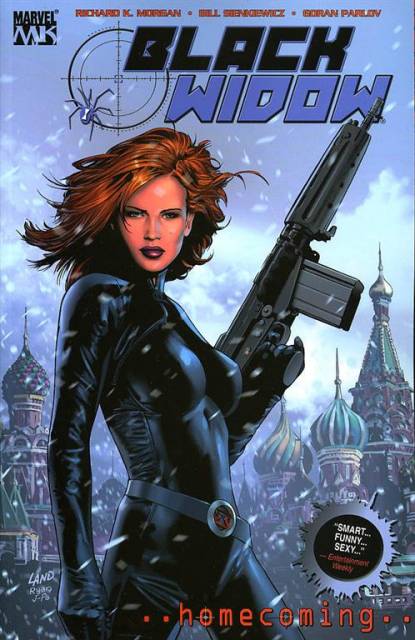 KB: With the influence you had on Black Widow’s characterization and how well the Avengers is doing, do you feel like she is accurately portrayed?
KB: With the influence you had on Black Widow’s characterization and how well the Avengers is doing, do you feel like she is accurately portrayed?
RM: Absolutely not, but what can you expect? I’ve said this before at length to Charlie Jane Anders over at Io9 – the Widow exists as an adjunct of a money-spinning superhero franchise catering to the tastes of 12 to 14 year old boys (and men who’ve somehow managed to grow up and retain a 12 to 14 year old boy heart). As such, she’s the epitome of unthreatening femininity grafted onto a pornstar’s T&A chassis and imbued with a set of plug-and-play boy-hero fisticuff character tics and reflexes. There’s nothing in that for women, nothing much in it even for genuinely grown-up males. The Widow I wrote for Marvel back in the early 2000s was her own woman, older, seasoned, hard as nails and unapologetic about it, centre stage in her own story. And let me tell you, that story flew like a fucking brick – the broad Marvel fanbase hated it. They didn’t like this genuinely empowered (and therefore genuinely feminist) female protagonist, and they voted with their wallets. The arc did disastrously low numbers by Marvel standards. So am I surprised by the version of the Widow that’s now emerged in the movies – hell, no! Just immensely saddened.
KB: Given the chance, would you ever want to return to continue her story?
RM: Are you fucking kidding! I’d love to. Writing Natasha, really letting her breathe, was a total blast! I’d jump at the chance to build a movie around her that did the same things Homecoming did. But there’s no way that’s ever going to happen. Don’t get me wrong, Marvel were great to work for; very professional, very supportive of what I was trying to do, and they really went out on a limb by letting me run with the character for a second arc when the first one had sold so dismally. But in the end, they killed the series for one very simple reason; it was a losing proposition – an expensive auteur project (I mean, we had Bill Sienkiewicz aboard, for Christ’s sake!), and doing dismally downward-spiralling numbers. By contrast, the version of the Widow you see in the movies is pulling in tens of millions of fanboy dollars. I mean, do the math – there’s just no way anyone’s going to let me within a mile of Natasha ever again! :-)
KB: Since you’ve had experience writing for both readers and gamers separately, the idea of bringing your dark fantasy series A Land Fit For Heroes to Steam, iOS, and Android as a gamebook is definitely intriguing to someone who enjoys both. How will a digital gamebook differ from the more traditional “Choose Your Own Adventure” type stories currently available? CYOA stories are typically made for a younger crowd, yet your series offers plenty of mature and controversial themes. Will these remain, and if so, how will they engage the player and the choices they make?
RM: That’s a question I’m not really qualified to answer – I never read the CYOA books back in the day, and I haven’t accessed any of the newer content either (these days I’m so busy I barely have time to read books or play games of any sort, let alone explore whole new formats!)
But my understanding from the brief the guys at Liber Primus have given me is that the vast majority of this stuff is YA-level in content. Land Fit for Heroes is avowedly not – it’s very much an adult fantasy, with adult themes and characters, and it’s as grim as anything I’ve ever written, which is saying something. So there’s that. :-)
 KB: How closely will the gamebook follow the existing story? Do players who have previously read the original have an advantage over newcomers to the series?
KB: How closely will the gamebook follow the existing story? Do players who have previously read the original have an advantage over newcomers to the series?
RM: The story in the gamebooks runs parallel to the main narrative in the novels – there’s some faint crossover with my characters in that some of them will make brief cameo appearances in the gamebook story, but the narrative thread itself follows three entirely new characters, and their adventures are disconnected from the storylines in the trilogy – though what they do and go through will be shown to have influence on the overall turn of events detailed in the novels. What this means for readers who’ve never read my stuff is that they’ll get a different initial angle of entry into my universe; but that won’t disadvantage them in any way as far as the gamebook story is concerned. And of course, if they’re curious about the wider world of the fiction, they can always go off and buy the trilogy after.
KB: What other projects are you currently working on?
RM: I’ve got a new novel up on the blocks at the moment – it’s a return to the universe of my 2007 novel Black Man, but set a good hundred or more years after the events of that story, and on a recently colonised Mars rather than on Earth. It’s called Thin Air and features another genetically modified cast-off protagonist, though a somewhat different and more down-at-heel one than Carl Marsalis in Black Man. I’ve gone right back to the noir wellspring I used in my Takeshi Kovacs books with this one – first person narrative, mean streets, corruption from high to low, a crime no-one wants solved and enemies at every turn. Feels good to be back behind the wheel of one of these!
KB: What sorts of media are you consuming in your spare time and would recommend?
RM: Not a whole lot of spare time to burn right now, I just moved from one end of the country to the other and I’m snowed under with busted deadlines. I am listening to quite a lot of music while I work, though; currently bingeing on 2 Cellos, Health and Cold Specks. And I just discovered an up-and-coming singer song-writer called Isaac Gracie whose single Last Words would make an awesome playout for a movie of my novel Market Forces. I just finished reading Ta-Nehisi Coates’ Between the World and Me, which I’d say is required reading for anyone interested in what’s happening to America at the moment and made me tremble with a father’s rage, and I’m now burning through John Horner Jacobs’ The Incorruptibles which is a superbly fresh-feeling mash-up of fantasy, alternate history and western adventure, the first of a trilogy whose second instalment, Foreign Devils, just came out – I’m running to catch up here! I’ve also been catching up on missed SF movies like Chappie and Ex Machina (both of which I guess I’d recommend seeing but neither of which in the end quite lit my fire) and more noirish fare like Scott Cooper’s Out of the Furnace and Dennis Lehane’s The Drop (both of which are awesome must-see triumphs). Still, sadly, waiting for someone in SF movie making – well, apart from George Miller, that is – to combine the vision and imagination in the former two with the close focus grit and commitment to human realities of the latter. In gaming, I’ve been making do with obsessive replays of The Last of Us, Max Payne 3 and Far Cry until there are enough good games out there to justify the expense of acquiring a next-gen console. At which point, I imagine I’ll be trying Bloodborne.
KB: Finally, where can you be found in various corners of the Internet?
RM: I keep a website at richardkmorgan.com where I try to find time and inspiration to blog at least once a month, and I’m on Twitter as @quellist1. Come on over!
Richard K. Morgan is the acclaimed author of The Dark Defiles, The Cold Commands, The Steel Remains, and Altered Carbon, a New York Times Notable Book that won the Philip K. Dick Award in 2003. A Land Fit For Heroes will be available on Android and ioS, as well as a PC version of the gamebook for Steam in the coming months.
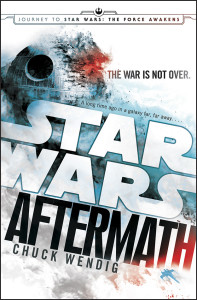 Taking place after Return of the Jedi, Chuck Wendig’s Star Wars: Aftermath tells the story of a group of people dealing with the transition between the downfall of the Empire and the rise of the New Republic. This comes after a move by Disney/Lucasfilm to put aside the previously published canon, that was established through comics and other novels, and start clean with the Clone Wars series and the films. With a clean slate and a movie release approaching in December, fans are eager to rediscover the Star Wars universe with Aftermath.
Taking place after Return of the Jedi, Chuck Wendig’s Star Wars: Aftermath tells the story of a group of people dealing with the transition between the downfall of the Empire and the rise of the New Republic. This comes after a move by Disney/Lucasfilm to put aside the previously published canon, that was established through comics and other novels, and start clean with the Clone Wars series and the films. With a clean slate and a movie release approaching in December, fans are eager to rediscover the Star Wars universe with Aftermath.
One of the more striking aspects of the book, and potentially the goal of the new canon, is the shift away from the previous generation of core cast. Of course it wouldn’t be a Star Wars narrative if the staple lines weren’t included. You can always bet there’s somebody uttering, “I’ve got a bad feeling about this.” The cast in Aftermath is designed to reflect the attitudes of the galaxy as the story develops, each one adapting to the new status quo amid the war between the New Republic and the Imperials.
My favorite character is by far the ex-loyalty officer, representing the disillusioned and tired Imperials. His story was an interesting development and watching his interactions with other Imperials and the other core characters was a highlight. The bounty hunter gave us some good insight into what is happening with the criminal underworld: what’s happening to a galaxy that doesn’t take to bad guys as well as it used to? Lastly, there’s the mother and son. The mother went off to war to find the husband that went to do the same, leaving the son behind to raise himself and now the two are thrown back together to pick up the pieces. The relationship between parent and child is a theme that runs through out the book, as we see parents teach their offspring the way of the galaxy and how they interpret the cycle of war and peace.
Much like how Han, Luke, and Leia were forced to depend on each other to defeat the Imperials, this new group is banded together by the threat of an Imperial attempt to regroup after the events of Return of the Jedi. They each have their own moralities and differences, but learn to adapt them to thwart the Imperials from establishing a foothold against the New Republic.
Adaptation is the key focus for the New Republic and Imperials as well. The New Republic is struggling to maintain its identity of freedom and democracy while maintaining a semblance of order and security in a war torn galaxy. This was the same type of conflict that transformed the previous republic into the Empire and that’s a idea that sticks around throughout the book. The Imperials are faced with reinventing their own identity from once being the most powerful organization in the galaxy to the new “Rebel Scum,” and are forced to survive using the tactics once employed by their enemies in the Rebel Alliance. For me the best part of the story came from the Imperials scrabbling to figure out what their next move is; ultimately there is an interesting conclusion that I didn’t really see coming.
Overall I would say this book is probably something like Avengers 2 for the Star Wars universe. A great blockbuster that was full of everything we could’ve expected, but at times felt the burden to help introduce the next phase of the story. Just like Avengers 2, Aftermath isn’t without its faults. How the story is structured, with seemingly frequent interludes breaking up the action, is a little annoying at times. Keeping that in mind, Aftermath is still an extremely important book for Star Wars fans. It’s the first branch of canon growing toward Force Awakens, so it’s a valuable bit of story to tide us over till December. However, it might not be as fun for people who are new to Star Wars. To keep with the metaphor, it would be like watching Avengers 2 and not having watched any other movie before it; you just wouldn’t get the point. If you are a fan of the Thrawn trilogy, the part of the old canon that used to be where Aftermath now stands, you would enjoy the parallels between it and Aftermath. In total I would say Aftermath has me excited to see where the story is going, and even more excited to see Force Awakens in December!
If you’re interested in other Star Wars books establishing the new canon, check out our review of Heir to the Jedi.